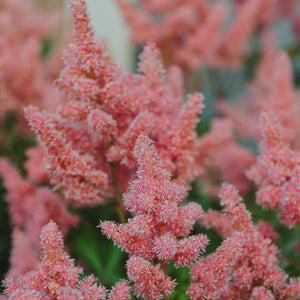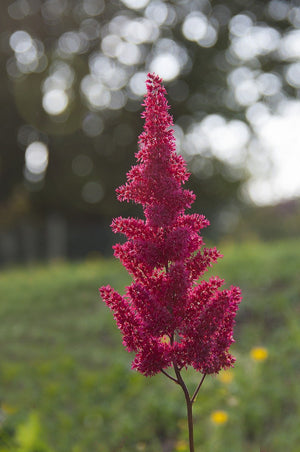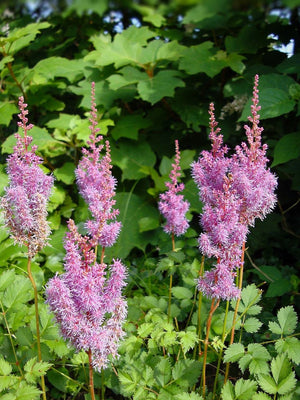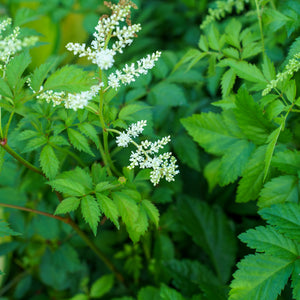The Astilbe Guide
Astilbe, commonly known as False Spirea, is a shade-loving perennial prized for its feathery plumes of flowers and lush, fern-like foliage. Thriving in moist, well-drained soil, Astilbe provides a burst of color from early summer to mid-summer, with varieties offering shades of pink, red, purple, and white. These hardy, low-maintenance plants are ideal for woodland gardens, shaded borders, and water features, adding elegance and structure to any landscape. Here’s everything you need to know about growing and caring for Astilbe.

About
Astilbe belongs to the Saxifragaceae family and includes a variety of species and hybrids that differ in height, flower color, and leaf texture. Native to Asia and North America, these perennials are highly valued for their ability to brighten shaded areas with their vibrant blooms and attractive foliage.
Among the most popular varieties, Astilbe chinensis 'Vision in Red' and Astilbe chinensis 'Vision in Pink' are known for their compact growth and richly colored flowers. Astilbe x arendsii 'Bridal Veil' offers elegant white plumes, while Astilbe japonica 'Montgomery' produces deep red flowers that stand out in shaded gardens. Taller selections such as Astilbe chinensis var. taquetii 'Superba' bring height and drama to the landscape.
Astilbe is an excellent companion plant for hostas, ferns, and heuchera, providing texture and contrast in shade gardens. With the right conditions, these plants will return year after year, enhancing garden beds with their delicate, feathery blooms.

PLANTING
- USDA Hardiness Zones: Most Astilbe varieties thrive in Zones 3-8, offering reliable cold tolerance.
- Soil: Prefers moist, well-draining, humus-rich soil with a slightly acidic to neutral pH.
- Sunlight: Best grown in partial shade to full shade. Some varieties tolerate more sun if soil remains consistently moist.
- Watering: Requires regular watering, especially during hot or dry weather. Avoid letting the soil dry out completely.
- Spacing: Space plants 12-24 inches apart, depending on the variety, to allow for full, bushy growth.
- Planting Time: Bare-root plants - Plant in early spring or fall when temperatures are cooler. Potted Astilbe - Can be planted throughout the growing season if adequate moisture is maintained.
To plant Astilbe, loosen the soil and incorporate compost or organic matter for improved moisture retention. Place the plant so the crown is at soil level, backfill with soil, and water thoroughly.

CARE
- Watering: Astilbe thrives in consistently moist soil. Water deeply and frequently, especially in dry conditions.
- Fertilizing: Apply a balanced, slow-release fertilizer in early spring to encourage lush growth and vibrant blooms.
- Pruning: Remove spent flower stalks after blooming for a tidier appearance. Cut back foliage in late fall or early spring to make way for new growth.
- Pests & Diseases: Generally resistant to pests and diseases but may experience occasional issues with powdery mildew or fungal diseases in overly humid conditions.
- Dividing: Divide clumps every 3-4 years in early spring or fall to maintain plant vigor and prevent overcrowding.

HOW TO USE
Astilbe’s striking blooms and foliage make it an excellent choice for a variety of landscape applications:
- Shade Gardens: Adds texture and color to shaded borders and woodland settings.
- Moisture-Rich Areas: Thrives near ponds, streams, or rain gardens where soil remains damp.
- Companion Planting: Pairs well with hostas, ferns, and coral bells for layered, textural interest.
- Cut Flower Gardens: Long-lasting blooms are excellent for fresh-cut floral arrangements.
- Mass Planting: Large groupings of Astilbe create a dramatic, colorful display in shaded garden beds.

Common Questions
- Should you deadhead Astilbe flowers? Deadheading is not necessary but can improve appearance. Some gardeners leave spent blooms for winter interest.
- When do Astilbe bloom? Most Astilbe varieties bloom from early summer to mid-summer, depending on the species.
- Do deer eat Astilbe? No, Astilbe is deer-resistant due to its bitter-tasting foliage.
- Does Astilbe spread? Astilbe spreads slowly through rhizomes but is not invasive.
- How to plant Astilbe? Plant in rich, moist soil with partial shade, spacing plants 12-24 inches apart.
- When to plant Astilbe? Early spring or fall is the best time to plant for strong root establishment.
- Are Astilbe deer-resistant? Yes, they are highly resistant to deer and other browsing animals.
- Is Astilbe poisonous to dogs? No, Astilbe is non-toxic to dogs and safe for pet-friendly gardens.
- Is Astilbe poisonous to cats? No, Astilbe is not toxic to cats and can be safely grown in households with pets.
Conclusion
Astilbe is a shade-loving perennial that brings vibrant color and texture to gardens with its feathery plumes and lush foliage. Whether used as a mass planting, a companion to other shade-loving perennials, or an accent near water features, Astilbe is a valuable addition to any garden. With varieties like Astilbe 'Ostrich Plume', Astilbe chinensis 'Vision in White', and Astilbe japonica 'Montgomery', there is an Astilbe for every gardener’s needs. Explore our collection and transform your shaded garden with these stunning, low-maintenance plants.
The Astilbe Collection
Sold Out
Sold Out
Sold Out
Sold Out






